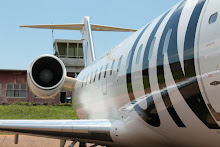Training Week 4: Family Orientation and Systems
First thing Monday was the final exam for indoc. Everyone in the class passed and the instructor said that she can't remember a time when everyone scored over 90. At noon, it was time for family orientation. The airline flew class members' families out for the day to meet management, enjoy a nice catered lunch and hear about life as an airline pilot. Afterwards, they were given a tour all of the company facilities and the simulators. It was a pretty nice thing to do. Monday was a good day.
Tuesday was the first day of systems class. It felt good to be re-immersed in to CRJ systems. As much as I thought had been forgotten started to come back out of long term memory storage. That is a very good thing as the CRJ is a complicated aircraft. I remember how difficult it was the first time around and am glad to have a leg up.
In the first four days we covered EICAS (Engine Information and Crew Alerting System), AC/DC electrical system, APU (Auxiliary Power Unit), Fuel System, Powerplant, Environmental Control System, Ice & Rain Protection, Fire Protection, Hydraulics, Landing Gear, Flight Controls, EFIS (Electronic Flight Instrument System), Oxygen & Emergency Equipment and Lighting. That's enough for four days, right?
Monday & Tuesday we'll be finishing up on systems with Navigation, Communications, EGPWS (Enhanced Ground Proximity Warning System 0r E Jip Whiz for short), Water & Waste, Aircraft Doors & AFCS (Automatic Flight Control System). Wednesday is the comprehensive systems test which is about 100 questions covering all systems. Multiple choice, true/false and my favorite...fill in the guess. Oh well, it's just another hurdle in a seemingly never ending race.
Thursday is the first of four CRM (Crew Resource Management) classes and Friday night is hangar night. We'll be spending about 8 hours in a CRJ learning about and performing tasks like pre-flight and emergency procedures.
Since I'm in severe study mode, if anyone has questions about the systems of the CRJ-200, I'll try to answer them for you. It will definitely be good study matter for me. Keep in mind, this is from a pilot's level of knowledge - not an A&P. I can't and won't build the system for you.
For anyone interested in learning a little more about the CRJ-200, here are some images of cockpit panels and descriptions of what each switch, switch light, button and dial does. Enjoy.
 Above is the glare shield, minus the AFCS, and the captain's side panel. The triangular black handle is called the tiller. It is used to steer the aircraft on the ground, up to 70 degrees.
Above is the glare shield, minus the AFCS, and the captain's side panel. The triangular black handle is called the tiller. It is used to steer the aircraft on the ground, up to 70 degrees.
The above panels are from the lower pedestal. There are several detail panels missing including the throttle quadrant, main radio tuning units, audio panels and FMS.



5 comments:
Mike,
I have truly enjoyed your journey's log - as someone who comes from the same area it's been good to follow your progress.
Mike, love your blog. I hope to be flying CRJ's soon too.
Here is my question-Does the crj have auto throttles?
Thanks! Scott, NYC
I enjoyed the pictures of the controls. Thanks for posting them. Makes my Cessna 150 look simple.
Here are some questions, if you have the time.
1) Is it possible to deploy the spoilers in flight. Even if it's forbidden, is it possible?
2) Do you train for inadvertent or uncommanded spoiler deployment.
3) If I read the schematic right, the wing de-ice keeps the wing at 50 degrees C, which is over 100 degrees F. That's surprisingly higher than needed to melt ice. It must sap performance some.
4) WHY A TILLER? I assume you have both rudder pedals and toe brakes, and have practiced with them for most of your pilot training all the way back to your Cessna 150 days. Is a third way to steer really needed? Heck, what if the guy on the other side of the cockpit wants to steer?
Thanks for the comments so far.
Scott in NYC -
The CRJ family has a very nice auto pilot system. However, one of the things I like about it is that it does not have auto throttles. The thrust must be manually adjusted during all phases of flight.
Charles,
1. The spoilers can be deployed during flight. The CRJ is a very clean aircraft and likes to go fast. There are several limitations on flight spoiler use, most importantly that they not be used below 300 feet AGL.
2. Yes we train for spoiler deployment. There are several procedures in the quick reference handbook (QRH). The flight spoilers are part of the ground lift dump system, which also has QRH procedures for malfunctions.
3. The 14th stage from the engines provides bleed air to the wings and cowls for anti ice, as well as thrust reversers. 14th stage air is very hot and if there is ever an overtemp situation, standby mode will cycle the wing heat on and off to maintain a constant temperature. Anti-ice does sap performance. During takeoff or landing, if wing and/or cowl anti-ice is switched on, you must turn off the 10th stage valves. The 10th stage air supplies pneumatics for engine starting, air conditioning and pressurization.
4. Ahh the tiller. It provides better low-speed maneuverability for tight turns. With the nose wheel steering on, you can turn up to 70 degrees. Straight ahead steering and turns with a large radius can be accomplished with the rudder pedals.
Some aircraft have tillers on both sides, but traditionally the captain always taxis.
Good questions. I hope the answers are what you're looking for.
Post a Comment